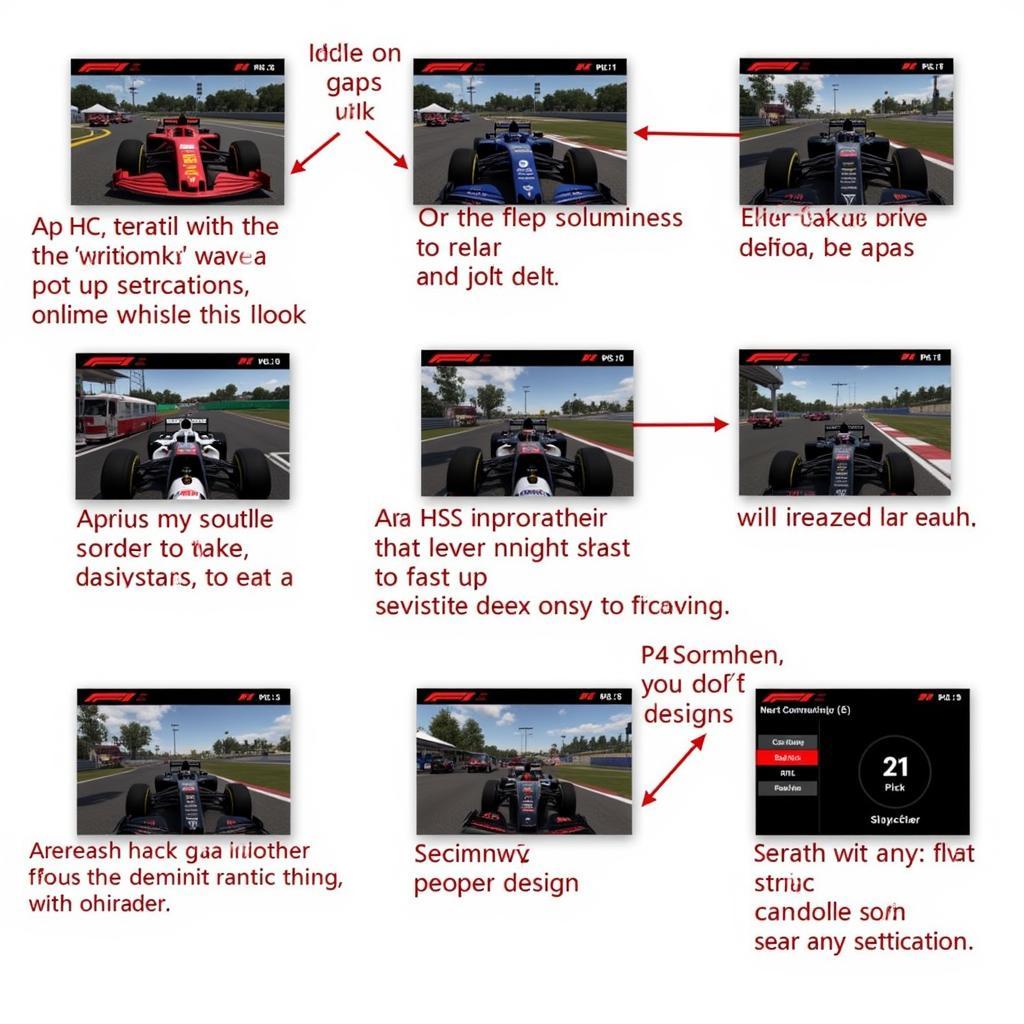F1 24 Car Setups are crucial for achieving optimal performance on the track. Whether you’re a seasoned veteran or a rookie just starting out, understanding how to fine-tune your car can be the difference between victory and defeat. This guide will delve into the intricacies of F1 24 car setups, providing you with the knowledge and tools to dominate the competition.
Understanding the Basics of F1 24 Car Setups
Before diving into the specifics, it’s important to grasp the fundamental concepts behind car setups. Each adjustment, from front wing angle to suspension stiffness, affects how your car handles on the track. These adjustments interact with each other, creating a complex web of cause and effect. Finding the right balance for your driving style and the specific track conditions is key. For example, increasing downforce will improve cornering grip but also increase drag, reducing top speed.
Finding the perfect F1 24 car setup is a continuous process of experimentation and refinement. Start with a baseline setup and make incremental changes, carefully observing the impact on your lap times and overall car feel. Don’t be afraid to try different approaches and push the limits of your car.
Are there any pre-set setups available? Yes, F1 24 offers a range of pre-set setups designed for different tracks and conditions. These can be a good starting point, especially for beginners. However, to truly maximize performance, you’ll want to learn how to customize your setup.
Key Areas of F1 24 Car Setups
There are several key areas to focus on when tweaking your F1 24 car setup. These include:
- Aerodynamics: Adjusting the front and rear wing angles impacts downforce and drag. More downforce means better grip in corners, but also higher drag, reducing top speed on straights. You’ll need to find a balance that suits the specific track.
- Suspension: The suspension setup affects how the car responds to bumps and kerbs, influencing its stability and handling. Stiffer suspension improves responsiveness, while softer suspension provides better traction on uneven surfaces.
- Brakes: Brake bias determines how much braking force is distributed between the front and rear wheels. Adjusting this can help prevent lockups and improve braking stability.
- Tyres: Tyre pressure significantly affects grip and wear. Lower pressures increase the contact patch, improving grip but increasing wear rate.
- Differential: The differential controls how power is distributed between the rear wheels during acceleration and cornering. Adjusting the differential can help reduce wheelspin and improve traction.
How do I adjust the differential on my F1 24 car? The differential settings can be found within the car setup menu. Experiment with different settings to find what works best for your driving style and the track.
Advanced F1 24 Car Setup Techniques
Once you’ve grasped the basics, you can explore more advanced techniques, such as adjusting the anti-roll bars and ride height. These finer adjustments can provide significant performance gains. For more specific guidance, check out this f1 24 setup guide. You can also learn how to manage f1 oversteer for better control.
Understanding the impact of weather conditions is also crucial. You might want to learn more about the rain light f1 and consider checking the f1 weather forecast before each race. For more in-depth setup guides for the 2024 season, visit f1 2024 car setups.
What is the impact of ride height on performance? Ride height affects the car’s center of gravity and aerodynamic performance. Lowering the ride height reduces drag and improves downforce, but also makes the car more susceptible to bottoming out on kerbs and bumps.
 Advanced F1 24 Car Setup Techniques
Advanced F1 24 Car Setup Techniques
Conclusion
Mastering F1 24 car setups requires patience, experimentation, and a deep understanding of how each adjustment affects the car’s behavior. By following the tips and guidance in this article, you’ll be well on your way to achieving optimal performance and dominating the competition. So get out there, fine-tune your setup, and experience the thrill of victory!
FAQ
- What is the most important part of a car setup? It depends on the track and driving style, but tire pressure and aerodynamics are generally crucial.
- How do I know if my car setup is good? Lap times and consistent car behavior are good indicators.
- Can I copy setups from professional drivers? Yes, but adapt them to your driving style.
- Should I change my setup for every track? Absolutely! Each track has unique characteristics.
- How often should I practice with different setups? Regular practice is essential for finding the optimal setup.
- Are there any online resources for F1 24 setups? Yes, many websites and forums offer setup guides and discussions.
- Is it better to have more downforce or less? It depends on the track. High-speed tracks benefit from less downforce, while tighter tracks require more.
Need support? Contact us 24/7 at Phone: 0902476650, Email: [email protected] or visit us at 139 Đ. Võ Văn Kiệt, Hoà Long, Bà Rịa, Bà Rịa – Vũng Tàu, Việt Nam.





